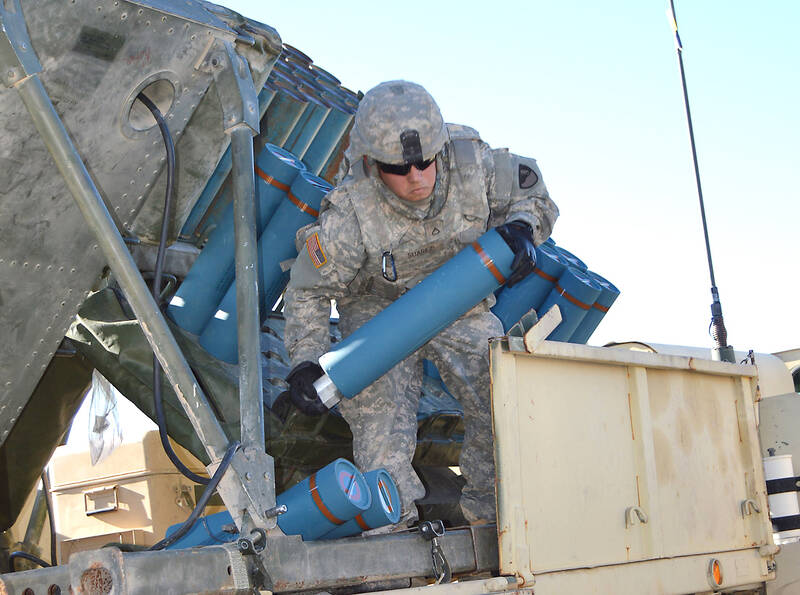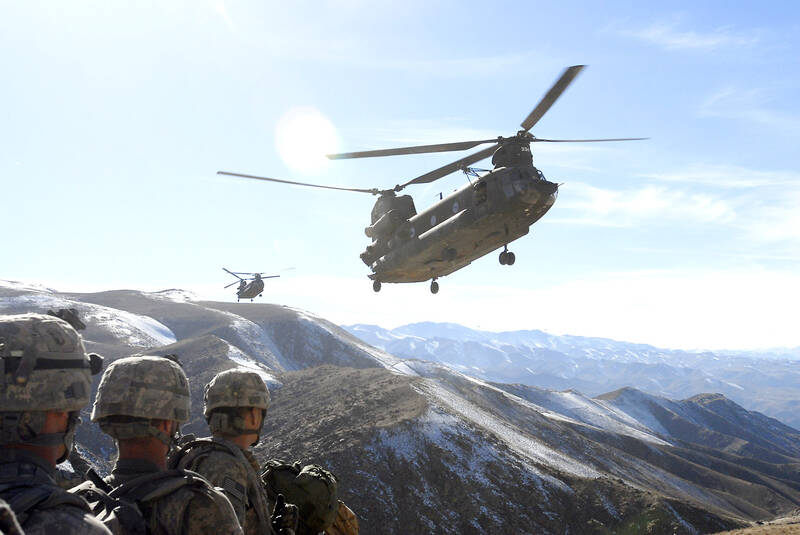In 2001 then-president George Bush said in an interview for ABC’s Good Morning America that he would do “whatever it took to help Taiwan defend herself.” When asked whether the US had an obligation to defend Taiwan and whether he would defend the island, Bush answered “Yes, we do ... and the Chinese must understand that. Yes, I would.” There was a furor.
Fast forward a few years. By the end of the Bush administration a US$12 billion backlog in US weapons sales to Taiwan had accumulated. The Bush administration, angling for People’s Republic of China (PRC) cooperation in the Middle East and elsewhere, was delaying arms sales — a classic case of the usual PRC leveraging of US needs to trade a transient favor for a permanent gain. A de facto “arms freeze” had been imposed, widely discussed in the media and complained about by US officials who had to deal with the real world, like the US Pacific Command (PACOM) then-commander, admiral Tim Keating, who mentioned the go-slow on arms for Taiwan in a speech at the Heritage Foundation in July of 2008.
DOING THE PRC’S DIRTY WORK

Photo courtesy of Wikimedia Commons
Those of you with long memories might recall that the Chen Shui-bian (陳水扁) administration had requested 66 F-16s from the US, a move the pro-PRC Chinese Nationalist Party (KMT) supported even as it gleefully used the arms freeze to criticize the Chen administration. Although typically the State Department, always eager to front for Beijing, was at fault in pro-PRC moves like the arms freeze, the Nelson Report, the Beltway insider report, blamed president Bush*.
Bush was followed by Barack Obama, whose famous “pivot” turned out to be more talk than walk, and whose Asia officials were drawn from Wall Street firms that did business with the PRC. The result was that the US supported then-president Ma Ying-jeou (馬英九) of the KMT, and in the 2011-2012 election campaign, Obama administration officials “leaked” an attack on then-candidate Tsai Ing-wen (蔡英文), Ma’s opponent. That attack, published in the Financial Times, was described in the Taipei Times as an “unsolicited call to the newspaper, aimed at crippling her campaign.”
That disgraceful incident harmed both the US and Taiwan and helped the PRC. The attack on Tsai in 2011 was a reminder that for decades the US supported the KMT and US officialdom served Beijing’s interests almost reflexively. Heritage Foundation commentator Walter Lohmann observed of the attack on Tsai that “the White House comments reflect an all-too-well-trained instinct for carrying China’s water on cross-[strait] issues” and noted that the PRC dictates the terms of what is “stability” and the US simply accepts that.

Photo courtesy of Wikimedia Commons
The Obama administration also blocked arms sales to Taiwan, canceling a US$1 billion package because it wanted PRC cooperation, this time on climate change. That is why Trump administration officials shifted the US policy to smaller arms sales of individual systems, so that they would not raise political hackles in Beijing or trigger PRC supporters in the US.
During the period of the “pivot,” the Obama administration looked on with benign indifference as the PRC occupied the South China Sea. The problems faced by the Philippines, Malaysia, Indonesia and Vietnam today in that area are in part traceable to the inaction of successive US administrations. Numerous Taiwanese have been to Cambodia and Laos, and can observe for themselves how they have become de facto protectorates of the PRC.
On Twitter recently former Trump administration official and defense policy expert Eldridge Colby, author of The Strategy of Denial: American Defense in an Age of Great Power Conflict, has amassed a large following arguing that the US should make opposing the PRC its priority over Ukraine, and that Taiwan should be spending more on its defense.

Photo courtesy of Wikimedia Commons
THE US: UNRELIABLE PARTNER
Colby is not entirely wrong about Taiwan’s defense spending, as I myself have argued, but he and his followers simply absolve the US of any blame in the construction of Taiwan’s defense posture and of its popular opinions about defense. The truth is that the US has catastrophically failed to lead, instead demonstrating repeatedly that it is a fickle and unreliable partner, indifferent to the fate of the nations of Asia, and willing to toss Taiwan’s needs aside whenever it wants something from the PRC. Taiwan and its people have responded accordingly.
The US leadership failure is multidimensional. Newspapers all over the world routinely print that the US position is that Taiwan is part of China. Corrections are almost never issued by the US State Department. The concealed US position on Taiwan makes it easy for malign voices in Taiwan and abroad to attack the US as an unreliable partner. It also cripples the US rhetorically, ceding the information ecosphere to the PRC’s expansionist fantasy history. Taiwanese of course see this, and they never hear the US saying clearly that its policy is that Taiwan’s status is unresolved, and that PRC expansionist fantasies are garbage. That is a colossal failure of US leadership: rhetoric has no tangible costs, after all, but it has tangible benefits.
Colby and others who call for greater Taiwan defense spending know perfectly well that the US does not have the industrial base to support expanded defense expenditures from Taiwan — they frequently say so. The lack of a US defense industrial policy is a tremendous failure of US leadership. It is not a coincidence that the same Wall Street players who have pushed PRC views in the media and in government also transferred the US manufacturing base abroad, especially to the PRC.
When people say that Taiwan should spend some entirely arbitrary figure like 4.5 percent or 10 percent or 3 percent of GDP on defense, they seldom observe that there is no place to spend that money. The US does not have the factories to service even its own needs, and no one else will sell Taiwan major weapons systems. At present there is a US$19 billion backlog of weapons deliveries from the US to Taiwan (about 2.5 percent of Taiwan’s 2022 GDP), yet the Biden administration has taken no urgent steps to rebuild the defense industrial base and vastly expand US maritime production and repair capability. Another colossal failure of US leadership.
The recent memorial holiday for the massacre known as the 228 Incident is a reminder that the US began by betraying the Taiwanese. It was US ships that transported then-governor general Chen Yi’s (陳儀) troops to Taiwan after World War II, and US equipment they used to slaughter the Taiwanese. Then the US backed the KMT and its brutal rule over Taiwan for decades. Another leadership failure.
If the US wants Taiwan to spend more on defense, it needs to vastly and rapidly expand its industrial base, change the way it talks about Taiwan’s status and provide the regional leadership we out here need to see. Without that, it looks like Colby and his fellows are simply setting Taiwan up to take the fall when US Asia policy fails again.
* Editor's note: An earlier version of this story indicated that the Nelson Report blamed Chen for the arms freeze. The report blamed Bush. The Taipei Times regrets the error.
Notes from Central Taiwan is a column written by long-term resident Michael Turton, who provides incisive commentary informed by three decades of living in and writing about his adoptive country. The views expressed here are his own.

Most heroes are remembered for the battles they fought. Taiwan’s Black Bat Squadron is remembered for flying into Chinese airspace 838 times between 1953 and 1967, and for the 148 men whose sacrifice bought the intelligence that kept Taiwan secure. Two-thirds of the squadron died carrying out missions most people wouldn’t learn about for another 40 years. The squadron lost 15 aircraft and 148 crew members over those 14 years, making it the deadliest unit in Taiwan’s military history by casualty rate. They flew at night, often at low altitudes, straight into some of the most heavily defended airspace in Asia.

Many people in Taiwan first learned about universal basic income (UBI) — the idea that the government should provide regular, no-strings-attached payments to each citizen — in 2019. While seeking the Democratic nomination for the 2020 US presidential election, Andrew Yang, a politician of Taiwanese descent, said that, if elected, he’d institute a UBI of US$1,000 per month to “get the economic boot off of people’s throats, allowing them to lift their heads up, breathe, and get excited for the future.” His campaign petered out, but the concept of UBI hasn’t gone away. Throughout the industrialized world, there are fears that

Like much in the world today, theater has experienced major disruptions over the six years since COVID-19. The pandemic, the war in Ukraine and social media have created a new normal of geopolitical and information uncertainty, and the performing arts are not immune to these effects. “Ten years ago people wanted to come to the theater to engage with important issues, but now the Internet allows them to engage with those issues powerfully and immediately,” said Faith Tan, programming director of the Esplanade in Singapore, speaking last week in Japan. “One reaction to unpredictability has been a renewed emphasis on

Taiwan’s democracy is at risk. Be very alarmed. This is not a drill. The current constitutional crisis progressed slowly, then suddenly. Political tensions, partisan hostility and emotions are all running high right when cool heads and calm negotiation are most needed. Oxford defines brinkmanship as: “The art or practice of pursuing a dangerous policy to the limits of safety before stopping, especially in politics.” It says the term comes from a quote from a 1956 Cold War interview with then-American Secretary of State John Foster Dulles, when he said: ‘The ability to get to the verge without getting into the war is